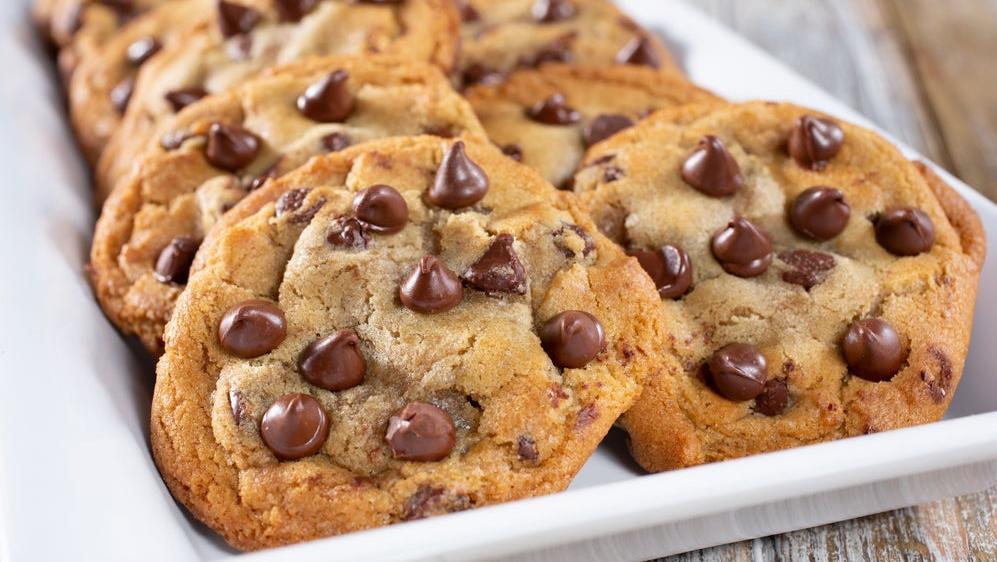How To Use Every Type Of Chocolate Chip In Your Baking
Which chips (or chunks) should you choose for your desserts?
If you're anything like me, the ideal time for baking stretches across most of the year. And if you're craving a simple, classic chocolate chip cookie, you might head to the baking aisle and be greeted with an abundance of choices. There are many chocolate chips from which to choose; which one is best? Here are seven leading types of chocolate morsels and the ideal baking scenario for each one.
Semi-sweet chocolate chips
Semi-sweet chocolate chips are the standard inclusion in basic chocolate chip cookies, and Nestle Toll House specifies their use (naturally) in the classic "back of the bag" recipe—the one that "started it all." Semi-sweet chocolate contains less added sugar than other varieties, which gives the baker better control over the amount of sugar in the batter; this makes it the preferred chip for many baking projects. The "semi" here often refers to cocoa or cacao content, which is roughly halved in most semi-sweet varieties.
Milk chocolate chips
Milk chocolate is sweeter than semi, as the name might imply, and will likely appeal to people with more childlike wonder or more of a sweet tooth. These chips contain milk powder, so they have a lighter hue than semi-sweet, and typically contain a quarter cocoa content. Some bakers prefer milk chocolate chips for melting as they are not known for holding their shape very well in cookies. Personally, I use a mix of milk chocolate chips and semi-sweet chocolate chips when I make cookies for my kids, since milk is too sweet for me and semi-sweet is too bitter for them.
Dark chocolate chips
Most adults I know prefer dark chocolate, but I'm sometimes convinced this is because we were told dark chocolate is good for us. However, if you do actually prefer dark chocolate chips, which usually contain 60-100% cocoa content, you can use them in place of semi-sweet or milk chocolate. They don't usually melt well at higher cocoa concentrations and can get chalky, so keeping them in their solid state works best. Note that while high-quality dark chocolate hovers around that 70% cocoa content, Toll House Dark Chocolate Morsels are only 53%.
Bittersweet chocolate chips
Bittersweet chips certainly earn their name: They might just strike the perfect balance of appealing to your childhood memories of milk chocolate and your dark soul that insists on something more complex. Bittersweet chips might have more like 65% cocoa (higher than semi-sweet) and they're a good option for a darker, richer, more grown-up chocolate taste, while still behaving the way milk or semi-sweet chips would in a recipe—unlike dark chocolate, which doesn't always get the melting properties quite right.
Mini chocolate chips
Mini chocolate chips are usually just miniature versions of semi-sweet chocolate chips. These don't serve any unique purpose independent of their larger counterparts except for cuteness and surface area. I prefer to use minis in scones or other "breakfast" sweets so the chocolate isn't as overpowering, but as you see in the video above, they can be used to great effect in classic chocolate chip cookies, too, offering smaller but more widely dispersed bits of sweetness throughout the batter.
Chocolate chunks
"Chunks" is not my favorite word in terms of mouthfeel—it's more reminiscent of vomit than dessert—but the look and texture of chocolate chunks gives cookies and other baked goods a more rustic, homemade look. The asymmetry of the chunks can bother picky eaters, so keep that in mind if you're making something that requires precision. However, the surprise element of the chunks lends itself nicely to fresh-from-the-oven cookies with still-melty chocolate. They are usually interchangeable with chips in recipes, though a more delicate dough might have trouble handling their heft.
White chocolate chips
White chocolate is, in fact, chocolate. Unless it's crap, it does have cocoa in it, usually cocoa butter rather than any cocoa solids. Bad white chocolate doesn't have depth or flavor; it's just flatly sugary-sweet. Good white chocolate, on the other hand, is velvety and complex, and you can get a roasty flavor out of it when you bake it. People often hate white chocolate, and usually that's because they've had cheap versions of the stuff. If you're going to use white chocolate, it's more important to invest in a quality product. Look for cocoa content of 20% or higher. While white chocolate chips are often mixed with milk, dark, or semi-sweet chips in recipes, proceed with caution: A friend once presented my daughter with a cookie like this and she yelled, "Why in the WORLD?" The combination is apparently not for everyone.
